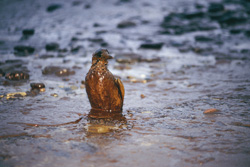Slick removal for oil spills
Oil spill disasters like the Erica and Prestige have reinforced how important it is to remove an oil slick as quickly as possible to avoid long-term ecological damage. Equipment to deal efficiently with excessively adhesive viscous oil is also a high priority for oil clean-up systems as well as a seaworthy vessel operable in rough conditions. EU funding for the 'Oil sea harvester' (OSH) project supported an initiative that aimed to develop a suitably equipped vessel to be on the scene as quickly as possible for damage limitation of an oil spill. The main objective of OSH was to design and develop a trimaran fitted with rotating prop housing or POD drives for improved manoeuvrability. The vessel would also be equipped with specially designed oil recovery systems housed in a unique tool carriage. For pumping high viscosity oil as in the Erika incident, OSH incorporated a positive displacement Archimedes screw (PDAS) type pump, a bonus being that this system would also be able to cope with low viscosity oil. Equipment was also developed to transfer the recovered pollutants to tanks on board the OSH vessel. Operation of the oil recovery system was tested at the Centre of Documentation, Research and Experimentation on Accidental Water Pollution (CEDRE) in France. A comprehensive economic analysis confirmed the commercial viability of the OSH vessel and its operability. Results of extensive tests and pilot runs indicate that the OSH can operate efficiently in high sea conditions to recover pollutants, notably high viscosity oil that is more dense than water and is notoriously difficult to pump. The complete OSH concept of vessel, tools and systems represents an interesting proposal for agencies like the European Agency for Safety at Sea and will help to minimise oil damage at the colossal level witnessed in previous oil spills in Europe.







